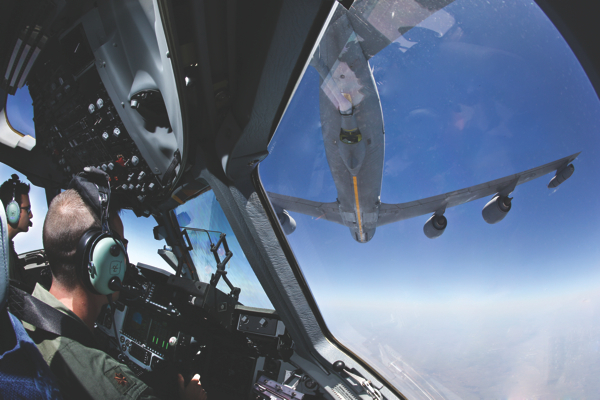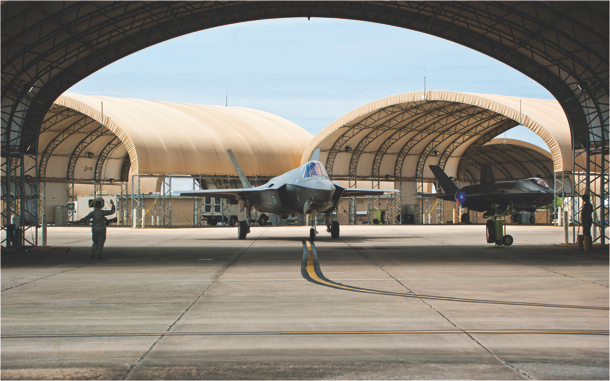The past 12 months have been a busy time for Air projects and there are further milestones ahead in 2016.
Nigel Pittaway | Melbourne
Leaving aside the Army/Navy Helicopter Aircrew Training System (HATS) project, which formally became a Joint Project (JP9000 Phase 7) in the reorganisation of project names last year, almost every month this has seen a significant milestone for an ongoing project, or the launch of new projects.
From a new projects perspective, there are not many existing Air Force platforms left to replace and focus is shifting towards initiatives intended to maximise the sum capabilities of the platforms it has either recently replaced, or is in the process of replacing.
The major initiative is Plan Jericho, launched by former Chief of Air Force, Air Marshal Geoff Brown at the Avalon Airshow in February 2015. Plan Jericho is designed to understand what capabilities are inherent in 5th generation technology and how to derive the maximum benefit from them.
A year in review
For the Air Force in particular, 2015 saw new capabilities introduced, enhancements to existing capabilities and a follow-on order for two more Airbus KC-30A Multi-Role Tanker Transports (MRTT).
 Credit: Defence
Credit: Defence
In fact, 2015 will go down as a good year for the KC-30A as it continues to mature into a formidable capability. During the year it earned its spurs in combat operations in the Middle East, completed certification of the fly by wire Aerial Refuelling Boom System (ARBS) and was taken off the Government’s Projects of Concern list.
Army and Navy Air projects also achieved major goals during the period, with the Lockheed Martin MH-60R becoming operational in Australia and the delivery of all seven Boeing CH-47F Chinook heavy lift helicopters (spoiler alert – Australia has requested FMS pricing for between 3 and 5 more Chinooks).
Taking things in chronological order, the first two Lockheed Martin F-35A Lightning II Joint Strike Fighters for the RAAF (Air 6000 Phase 21/B) were delivered to Luke Air Force Base in Arizona, where they are now well-established as part of an international training pool of aircraft operating with the USAF’s 56th Fighter Wing.
Air 6000 was also in the news in February from an Australian industry perspective, when then-Defence Minister Kevin Andrews announced that BAE Systems Australia and TAE had won important contracts for the maintenance of the F-35 and its components in the Asia-Pacific region.
BAE Systems has been assigned the role of South Pacific Regional Depot Airframe, Maintenance, Repair, Overhaul and Upgrade provider, and will begin supporting the F-35 program from Williamtown in early 2018. Tasman Aviation Enterprises (TAE) will service the F135 engine from its facilities at Amberley.
"June saw the formal commissioning of the Navy’s first MH-60R Squadron at Nowra."
Also in February the government announced that flight training on the RAAF’s Alenia Aermacchi C-27J Spartan battlefield airlifter (Air 8000/2) would begin with L-3 Communications in Waco, Texas.
In early March then minister Andrews announced that the KC-30A (Air 5402) had been removed from the Projects of Concern list, following successful completion of a boom remediation program to address shortcomings with the ARBS.
Air 5402 was in the news again in May with the report that successful contact using the ARBS with another KC-30A and since that time the aircraft has carried out trials with a number of receivers, including the RAAF’s Wedgetail and, most recently, a USAF F-35A.
The Wedgetail program (Air 5077) achieved a milestone of its own in May, with the declaration of FOC. In this case, FOC represents the ability of the entire capability (platform, logistics, management, sustainment, facilities and training) to support ADF operations.
Also during the busy month for Air projects, the Army formally commissioned the first two of seven CH-47F Chinooks it is acquiring under Project Air 9000 Phase 5C. The Chinooks are replacing six earlier CH-47Ds with the Army’s 5th Aviation Regiment in Townsville.
June saw the formal commissioning of the Navy’s first MH-60R Squadron (Air 9000 Phase 8) at Nowra, marking the formal induction of both the squadron and the helicopter into the fleet. Fifteen of the 24 ‘Romeos’ had been delivered by the end of the year and the type has already begun First of Class flight trials aboard the Navy’s Anzac frigates.
The final day of June saw a ceremony at RAAF Richmond to mark the arrival of the first C-27J in Australia and by the end of 2015 two aircraft were conducting training and operational test and evaluation with 35 Squadron. A further three aircraft have been retained in Waco for the ongoing training of RAAF air and ground crews.
The following day, Minister Andrews announced that two more KC-30As would be acquired for the RAAF, for delivery in 2018. The two aircraft are ex-Qantas A330-200s which are a similar age and configuration to the five existing KC-30As and by September the first of these was already at Airbus Defence & Space’s facility in Getafe, outside Madrid, awaiting conversion to tanker configuration.
Fast jets
An important day for RAAF airpower followed at the end of July with the formal rollout of the first Boeing EA-18G Growler airborne electronic attack aircraft. Twelve Growlers are being acquired under project Air 5349 Phase 3 and, after a period of training and work up in the US, the first batch of aircraft will be delivered to Amberley in 2017. When fully operational in early 2018, Australia’s Growler fleet will represent the only tactical airborne electronic warfare capability outside the US Navy and Marine Corps.
Phase 2B of Project Air 7000 made news in August when the US Navy and Boeing signed a US$1.49 billion contract for the delivery of 13 P-8A Poseidon maritime surveillance aircraft, as part of the second full-rate production batch. Four of the aircraft are for the RAAF and a further four will follow in the next FRP batch in 2016. A further four options, which would take total acquisition under Air 7000 to 12 aircraft are expected to be exercised with the release of the White Paper.
Also in August, Boeing delivered the seventh and final CH-47F Chinook to the Army three weeks ahead of schedule.
Arguably one of the worst-kept secrets in the defence world was finally made public in early September, when Minister Andrews finally announced that Team 21, an industry consortium of Lockheed Martin, Pilatus and Hawker Pacific had won the bid to supply the ADF’s new Pilot Training System under project Air 5428.
Under the contract, Team 21 will deliver 49 Pilatus PC-21 aircraft, with aircraft expected to begin arriving in Australia in the middle of 2017. In addition, Basic Flying Training will relocate from Tamworth, where BAE Systems provides aircraft and facilities, to be undertaken in-house at RAAF Base East Sale. The details of the program were still under negotiation as this edition of ADM went to press.
 Credit: Defence
Credit: Defence
The most recent milestone before ADM closed for press was the delivery of the 8th and final Boeing C-17A Globemaster III strategic transport aircraft under an additional Air 8000 contract on November 2. The seventh had arrived at Amberley in July and the two aircraft were delivered in record time, having been built as ‘white tail’ aircraft by Boeing and announced by the Australian government in October 2014.
More milestones in 2016
In the absence of the long-promised (and much-awaited) Defence White Paper and Defence Capability Plan, and a reliable crystal ball, it isn’t easy to predict which projects may surface in the next year or so.
Certainly the major projects now underway will achieve more milestones – the first flight of the first Australian P-8A in the northern summer and Final Operational Capability for the KC-30A being two such likely contenders.
There’s a decision to be taken in 2016 on the firm order of the Northrop Grumman MQ-4C Triton high-altitude long-endurance maritime surveillance UAS – a decision which, it would seem, will almost certainly occur.
Beyond that there’s a strong possibility that a project to acquire an armed UAS will surface next year. Certainly the capability has been referred to by previous Defence Ministers and the former Chief of Air Force as a likelihood for the future. The fact that General Atomics, the maker of the Reaper platform, opened a Canberra office in late November is also a good indication that something is on the horizon.
One of the potential projects which ADM understands is yet to be officially approved, but a strong candidate to move into the spotlight in 2016, is the replacement of the RAAF’s Special Purpose Aircraft (VIP) fleet. The leases on the current Boeing 737-BBJ and Bombardier Challenger CL604 aircraft are due to expire in the next two or three years and although both the Air Force and Government will not go out of their way to publicise a replacement program – for obvious reasons – a project needs to formally begin soon.Perhaps this is why a RAAF team was in Spain late in the year to discuss the inclusion of at least one if not two VIP interiors in the KC-30As now under conversion.
COMMENT
Over the past decade, the RAAF has been systematically replacing its legacy platforms with modern, flexible and (largely) network-capable new aircraft.
|





